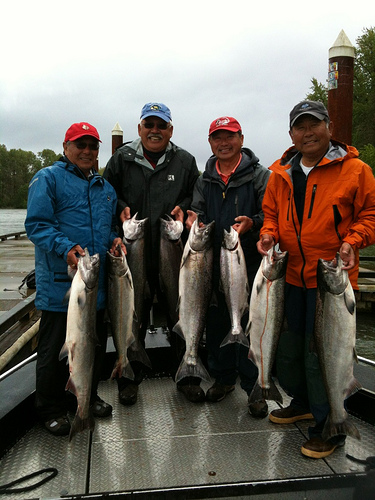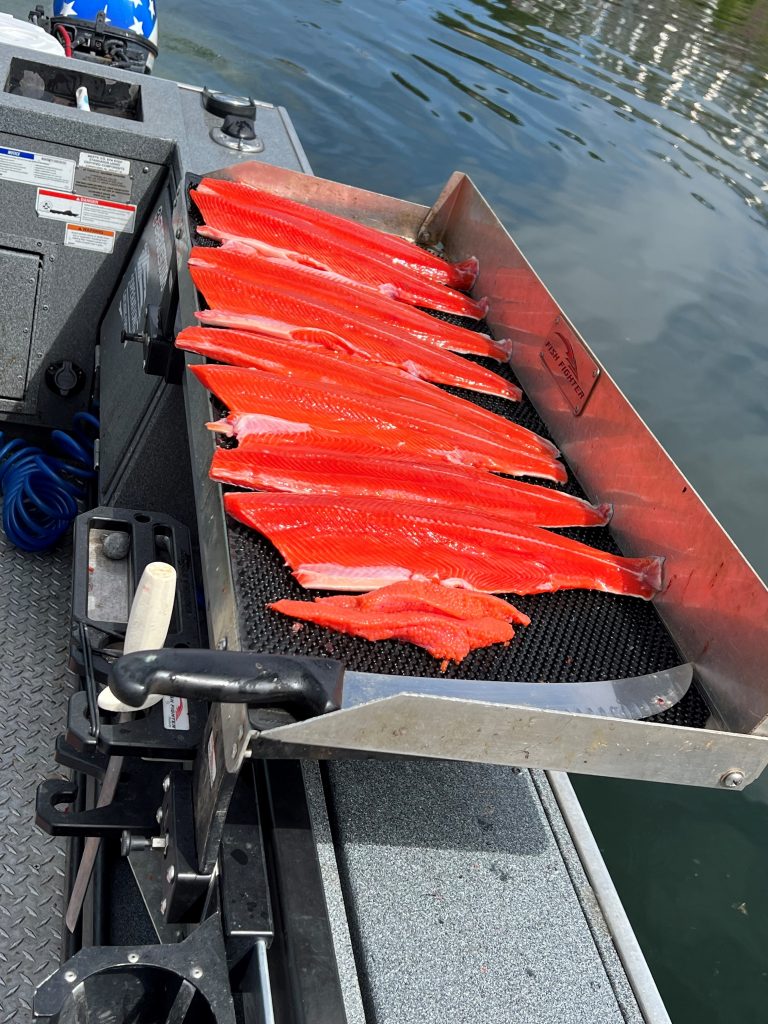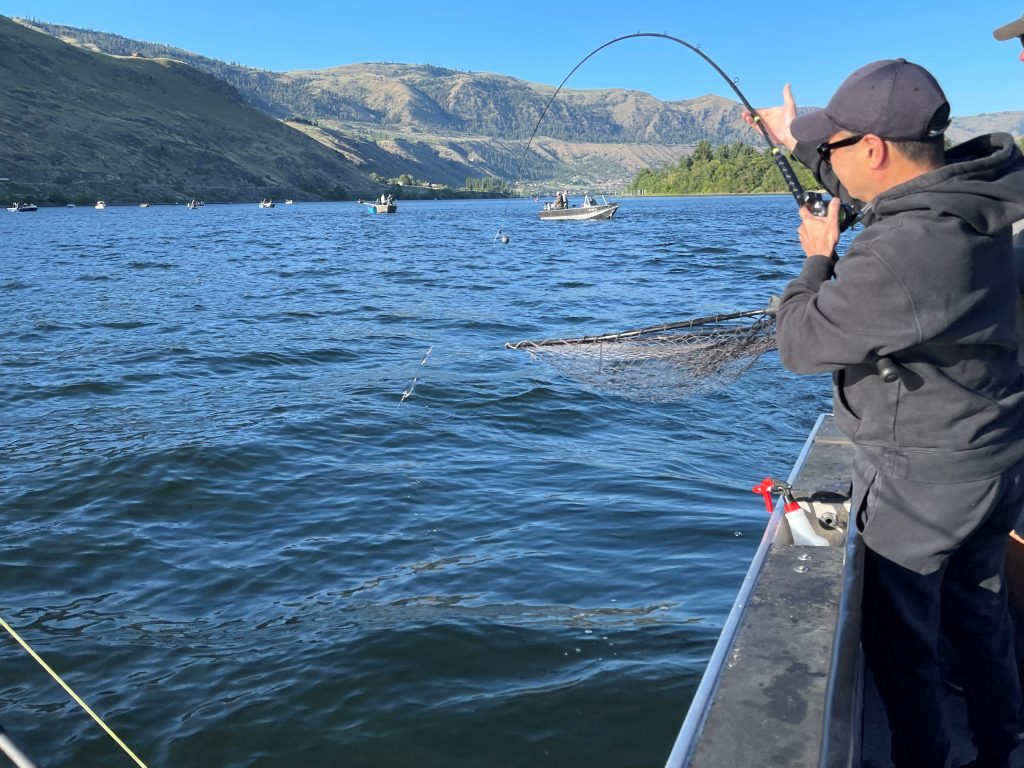Here’s some holiday cheer to get excited about! If the stars align, spring and early summer Columbia River salmon returns could offer decent fishing in 2024 Leave a reply

Contributed by Mark Yuasa, WDFW
What better way to celebrate the upcoming holidays than relishing some possible early good news for 2024 Columbia River salmon returns!
The Washington Department of Fish and Wildlife (WDFW) this past week released the Columbia River spring and early summer salmon forecasts and indications continue to point toward plenty of fishing opportunity excitement along many points of the Big-C.
The wild and hatchery spring Chinook forecast expected to return to the Columbia River is 187,400, compared to a forecast of 315,600 (197,000 in 2022 and 143,200 in 2021) and an actual return of 216,586 (274,495 and 152,675).
If the numbers fall around the prediction, the 2024 return could potentially be the sixth largest spring Chinook return seen in the last ten years and the 18th largest since 1979.
The 2024 upriver spring Chinook forecast to the Columbia River mouth of 121,000 is less than (86 percent) last year’s actual return of 141,179 (fifth largest in last ten years). If the run comes in as forecast it would be the sixth largest return in the last 10 years and the 20th largest since 1979.

There are always a lot of “if’s” that always come into play for spring salmon fisheries, especially along the lower river below Bonneville Dam, are water conditions, and while not a stellar return “if” the conditions are favorable then it could lead to some good times for anglers chasing Spring Chinook.
The 2024 Snake River spring/summer Chinook salmon portion is 63,000 (down from 85,900 forecast and 82,433 actual return in 2022 and 68,000 and 60,939 in 2021.
In general salmon returns over the past several years are trending toward the positive end of the spectrum. Improved ocean conditions an ideal outmigration path without a drought, flooding or dangerous elevated water temperatures could be the key factors for their resurgence.
Spring Chinook salmon are the first migrating salmon to arrive in Washington waters and known for their heavy Omega-3-laced, red-orange-colored meat, which is very comparable to Alaska’s Copper River salmon stocks.
These spring Chinook salmon enter the Columbia River from February through June and peaks in March through early- to mid-April and spawn in tributaries from August through October.
It isn’t unusual each winter to see the first spring Chinook salmon caught in January or early February either in the Lower Columbia, Multnomah Channel or Lower Willamette. The fishery creates a frenzy in late winter as many salmon anglers hit the water soon after the New Year hoping for a late holiday gift in the shape of a fresh salmon for the dinner table.
Under the current permanent WDFW regulations, the 2024 spring Chinook fishery on the Lower Columbia would be open daily beginning Jan. 1 through March 31 from Buoy 10 to the Interstate-5 Bridge.

On the Washington side of Lower Columbia, the Kalama spring Chinook forecast in 2024 is 1,900 (2,400 was forecast with an actual return of 2,525 in 2023). The Cowlitz is 4,700 (9,000 and 6,217). The Lewis is 3,400 (4,700 and 3,191).
On the Oregon side of Lower Columbia, the 2024 Willamette River spring Chinook run of 48,700 is down from a forecast of 71,000 but up from an actual return of 38,373 in 2023.
The spring Chinook forecasts to tributaries above Bonneville Dam in the Wind is 4,200 (4,400 forecast and actual return of 5,068 in 2023). Drano Lake is 5,300 (8,000 and 7,550). The Klickitat forecast is 1,300 (1,400 and 651).
According to the WDFW number crunchers, the 2024 Wind River spring Chinook forecast is greater than the recent five-year average return of 3,500 and like the recent 10-year average return of 4,100.
The 2024 Drano Lake (Little White Salmon River) spring Chinook forecast is less than the recent five-year and 10-year average returns of 6,300 and 8,100, respectively.
The 2024 Klickitat River spring Chinook forecast is like the recent five-year average return of 1,300 and less than the recent 10-year average return of 1,800.
WDFW and the Oregon Department of Fish and Wildlife will host a meeting around the middle or end of February to decide on all Columbia spring Chinook sport fisheries. There is an annual 30 percent buffer on the Columbia spring Chinook mainstem fisheries that protects against overfishing.
As in the past, additional in-season meetings from March through early June will provide updates on actual returns and ongoing fisheries as they become available with a chance of extending the season if the run appears larger than expected.

Other promising early summer salmon forecasts
The early summer salmon fisheries for Chinook and sockeye along the Upper Columbia River from Wenatchee to Chelan Falls and up to Brewster has been a boon the past several years with good to excellent catches depending on the timing.
The 2024 Upper Columbia summer Chinook salmon return is a promising 53,000 down from a forecast of 85,400 and near an actual return of 54,722 in 2023 and 56,300 and 78,444 in 2022.
Fishing for summer Chinook was good when it opened on July 1 in 2023 and the entire month of July is usually the best period but can be productive into early August as schools of fish move upstream and hold in cooler water. Anglers can track when it is time to go by checking the dam counts along the Columbia.
The hype around the Upper Columbia sockeye fishery may onto hold its reputation again during the summer of 2024 as a promising forecast of 401,700 is expected to jam the river.

The forecast in 2023 of 234,500 was waxed by the actual return of 329,040. This also came off the heels in 2022 when the unexpected actual sockeye salmon return to the Upper Columbia topped 664,935 (198,700 was the preseason forecast) and was the largest run since Bonneville Dam was erected in 1938. The 2024 forecast is also well above the 2020 return of 345,018 which was the highest return since 2016.
The key driver for the upper-river fisheries is an Okanogan sockeye salmon run forecast of 288,700 in 2024 (187,400 was forecast with an actual return of 179,655 in 2023, and 175,700 and 513,317 in 2022).
Many of the sockeye linger in the Brewster Pool, a popular early-summer deep-water salmon fishing location on Upper Columbia.
Sockeye migrate from its confluence just below Chief Joseph Dam, north into its headwater lakes in British Columbia that is known for a notoriously warm water barrier and changing river flow patterns in the summer. In 2023 and 2022, colder water throughout the mid- and upper-Columbia had sockeye darting straight up into the Brewster Pool generating good fishing in early summer and into August.

The summer-migrating sockeye are learning to adapt their upstream migration timing in recent years therefore most fish returns are peaking sooner than later in the summer. Over the past few decades, the run would peak by early July, but it’s shifted to late June and has resulted in higher sockeye survival in recent years.
The Lake Wenatchee sockeye salmon forecast is also promising with a whopping 97,000 up from a 44,300 forecast in 2023 with an actual massive return of 146,875. The 2023 forecast is well above the spawning escapement objective of 23,000 at Tumwater Dam, and if that happens look for an excellent late-summer sport fishery in the lake.
You can find all the early Columbia River spring and summer salmon forecasts by going to the WDFW website.
Other statewide salmon forecasts will occur during a public meeting in early March with a location to be determined. This meeting will provide a first glimpse of many forecasts for Washington salmon including Chinook, coho, sockeye, chum, and pinks.
Those will be followed by a Pacific Fishery Management Council (PFMC) meeting March 5-11 where initial 2024 ocean fishing options will be adopted. Two tentative WDFW North of Falcon public meetings in March will also shape fisheries for inner-marine and freshwater salmon fisheries.
The final salmon seasons will be adopted when the Pacific Fishery Management Council meets with state, federal and tribal fishery managers on April 5-11 in Seattle.
(Mark Yuasa is a Washington Department of Fish and Wildlife Communications Manager. He also was the outdoor reporter at The Seattle Times for 28 years.)

